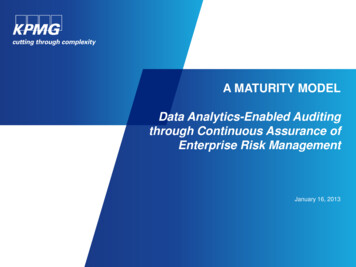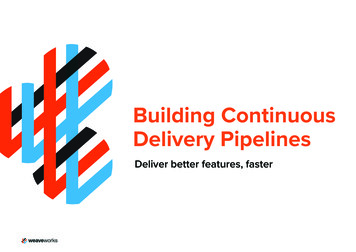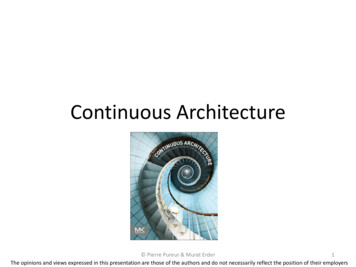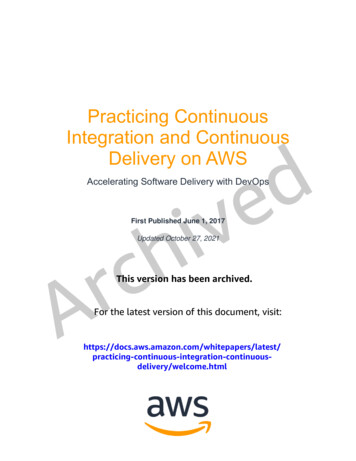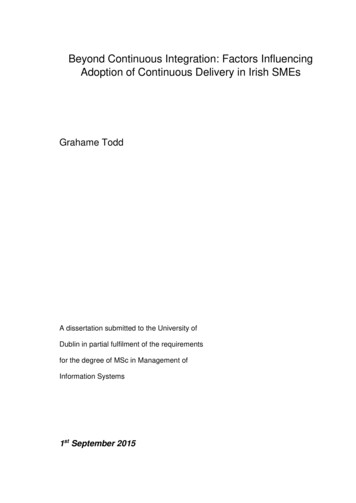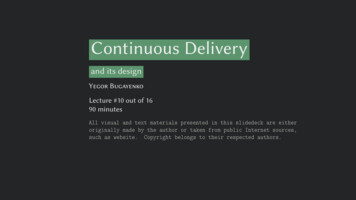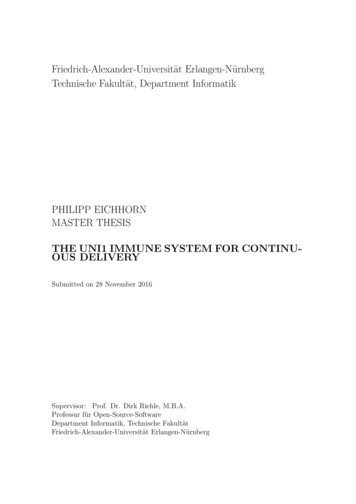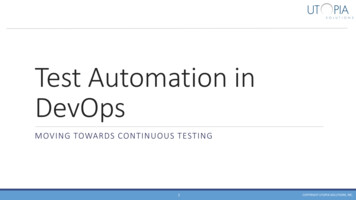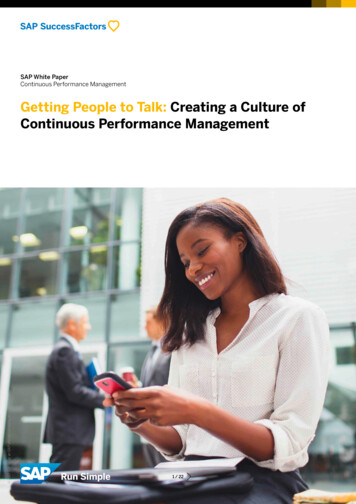
Transcription
SAP White PaperContinuous Performance Management 2017 SAP SE or an SAP affiliate company. All rights reserved.Getting People to Talk: Creating a Culture ofContinuous Performance Management1 / 22
Table of Contents4Introduction5Studying the Conditions that MakeContinuous Performance Management Work20 ConclusionJoe Sherwood and Steven HuntSAP SuccessFactors HCM Research2 / 22 2017 SAP SE or an SAP affiliate company. All rights reserved.
Continuous Performance ManagementThe need to more effectively engageemployees coupled with advances insocial, mobile, and cloud technology havecreated an explosion of innovation incontinuous performance managementmethods. The primary goal of continuousperformance management is to createeffective ongoing conversations andfeedback between employees, managers,and coworkers to drive agile andcontinuous performance improvementand development. Putting continuousperformance management into practiceinvolves much more than creating a newprocess or deploying a new application.3 / 22 2017 SAP SE or an SAP affiliate company. All rights reserved.
Continuous Performance ManagementIntroductionContinuous performance management requireschanging the behavioral habits of managers andemployees to engage in conversations that otherwise might not happen. SAP SuccessFactors hasa growing number of customers who are activelypursuing a continuous performance management model. They are learning through real-worldexperience what it takes to make continuous performance management successful. This papershares insights gained from working with thesecustomers on what it takes to make continuousperformance management work.WHAT MAKES CONTINUOUS PERFORMANCEMANAGEMENT DIFFICULT?The idea of continuous performance management is not new. For decades, companies haveadvised managers that performance management conversations should be ongoing throughout the year. However, managers were rarelyheld accountable or recognized for engaging inongoing coaching discussions. As a result, manyperformance management systems developedinto an annual exercise in completing forms andhaving uncomfortable conversations centeredaround vague recollections of past performance.In contrast, a continuous approach to performance management embraces processes thatencourage more frequent feedback conversations and proactive discussions about development. These processes downplay, and in somecases totally eliminate, the use of backward-focused performance evaluations and annualratings peformed by managers. Instead, managers and employees benefit from technological advances and applications that facilitate more frequent coaching conversations. These tools canalso collect data throughout the year to simplifyand increase the accuracy of assessments thathelp guide total workforce managementdecisions related to compensation, staffing,and development.The success of continuous performance management hinges on managers and employeesactively engaging in effective ongoing dialogueabout performance and development. Mostmanagers and employees know they shouldhave these sorts of ongoing feedback discussions, but many fail to do so. This is one of theprimary challenges associated with continuousperformance management. Feedback conversations do not come easily for many people. Establishing new patterns of behavior can be difficult,and often people lack the necessary skills ormotivation. Implementing continuous performance management is much like changinghealth habits. It is one thing to recognize that ahealthy diet and regular exercises are important,or even to join a gym and buy vegetables; it isanother to actually live a healthy lifestyle. Likemanaging one’s health, the main challenge withcontinuous performance management is oftennot a lack of knowledge or resources, but inchanging daily habits so that the understandingof how performance should be managed alignswith how it is managed.4 / 22 2017 SAP SE or an SAP affiliate company. All rights reserved.
Continuous Performance ManagementStudying the Conditions that MakeContinuous Performance Management WorkSAP SuccessFactors has more than 3500 customers using our performance management technology. Many of our customers have invested considerable energy to transition to more continuousperformance management. Starting in 2017, webegan a series of ongoing interviews with manyof these customers, representing a mix of industries, geographies, and size, to identify what conditions are associated with a successful move tocontinuous performance management. A number of these customers are making extensive useof technology recently developed by SAP SuccessFactors specifically designed to stimulatemore continuous performance conversationsand feedback. Aptly named Continous Performance Management (CPM) and delivered as partof SAP SuccessFactors Performance and Goals,these capabilities enable and facilitate the moveto continuous performance management processes. Throughout the paper we provide illustrative examples of how this technology is playing arole in enabling companies to implement continuous performance management. This paper isnot about technology per se, but many of thecontinuous performance management methodsdiscussed in this paper could not be deployed ina scalable and sustainable fashion without theuse of modern, cloud-based technology solutions. This report provides real-world insightsfrom customers who are on the path toward continuous performance management.Customers vary considerably in their approach tocontinuous performance management based ontheir unique needs and organizational cultures.However, we discovered several common themesassociated with companies that are successfullydeploying continuous performance managementprograms. By coupling these patterns with findings drawn from empirical research studying employee feedback and performance, we have identified a list of conditions that influence thesuccess of continuous performance management programs. Table 1 lists eight conditions thatare associated with more effective continuousperformance management processes. The effortneeded to implement continuous performancemanagement and the value it provides are bothinfluenced by the degree to which these conditions exist in an organization. Note that theseconditions represent an ideal. None of the customers we interviewed, including some withvery effective continuous performance management processes would claim to have fully addressed all eight conditions. With that said, themore these conditions exist, the more value companies receive from continuous performancemanagement processes and tools. Conversely,the more companies invest in continuous performance management, the more likely they are tocreate the conditions in Table 1. Most of theseconditions are outcomes of using continuousperformance management over time. Not meeting some of these conditions is not a reason toback away from pursuing continuous performancemanagement. Rather, it’s likely that the more acompany fails to create these conditions, the moretime and effort it will require to achieve the transformation necessary for realizing significant value.The remainder of this document discusses eachof the conditions in Table 1 in more detail, andprovides suggestions on how to create andstrengthen them over time.5 / 22 2017 SAP SE or an SAP affiliate company. All rights reserved.
Continuous Performance ManagementTable 1.Summary of conditions facilitating a successful move to continuous performance managementBuy-in andMotivationContinuous performance management only works when leaders in the organizationand process stakeholders have a strong commitment to its value. They must perceive the cultural and business benefits associated with continuous performancemanagement as worthy of their time, energy and resources.Feedback-rich Continuous performance management is easier in companies where people are alCultureready accustomed to regularly giving, seeking, and receiving feedback.Goal-Oriented Continuous performance management is easier in companies where goals andCultureroles are well-defined and communicated, and people are held accountable. Peopleshould have a clear sense of shared purpose and commitment toward organizational objectives.QualityRelationshipsContinuous performance management is more effective when there is a strong levelof trust between managers and employees. People are more willing to give and receive feedback from those they know and believe are committed to their success.Training onGiving andReceivingFeedbackContinuous performance management only works if managers and employeesknow how to give and receive feedback. Feedback must be delivered appropriatelyto maximize performance and engagement. Poorly delivered feedback can seriouslyhurt performance and commitment.Transparencyof Data andTalentDecisionsContinuous performance management works better when people understand howtalent decisions are made. The better they understand how these decisions are made,the more comfortable they will be with openly talking about their performance.FeedbackSystemsContinuous performance management depends on regular feedback conversations.It is important to have a defined structure that triggers and encourages routinedialogue and feedback, and maintains a centralized and accessible record ofthese uous performance management depends on regular feedback conversations.It is important to have triggers that encourage routine dialogue and feedback, andmaintain an accessible record of what is discussed.6 / 22 2017 SAP SE or an SAP affiliate company. All rights reserved.
Continuous Performance ManagementBUY-IN & MOTIVATIONDepending on what your performance management process looks like today, adopting continuous performance management may represent asignificant change that influences a range of HRprocesses and business practices. If key stakeholders are not on board, a smooth take-off andtransition to continuous performance management will be more difficult. While it may be unrealistic to expect every person to be supportive ofthe change, there are many things you can do toincrease organizational buy-in including: Clearly define what you are going to change andwhat it will take. Have candid discussions abouthow continuous performance management will affect managers, employees, business leaders, andHR professionals. Table 2 includes a brief discussion of the value continuous performance management provides to different stakeholders andwhy their support is important. Define in clear behavioral terms what these people will be requiredto do in the future that they may not be doing now.Have open and honest discussions around whypeople may resist the change, and what is neededto enable and support the transition to a continuous performance management model.Table 2. Differentiated value of continuous performance management by job roleWhat they want to know Why their support matters Seniorleaders How is continuous performance management linked to businessperformance? How does continuous performancemanagement align with the competitive strategy of the business? Employees take cultural cues fromtheir managers, who in turn take cuesfrom their leaders. Support from senior leaders demonstrates how seriously the organizationtakes the change.HRprofessionals How does continuous performancemanagement positively impact otherHR processes like compensation, staffing, and development? How does continuous performancemanagement lead to improved performance review processes? It’s important that HR professionalsknow how changes are going to affectthe other processes they manage thatmay have links to performance management. They are also likely to bear theburden of change management effortsrelated to continuous performancemanagement so they must understandhow to communicate its value.7 / 22 2017 SAP SE or an SAP affiliate company. All rights reserved.
Continuous Performance Management Create a vision that provides justification forcontinuous performance management. Thismay include highlighting how continuous performance management will address problemswith previous performance management systems. But it should also emphasize how continuous performance management will add valuefor employees, managers, and leaders beyondpast practices, and how it ties to broader organization values and business priorities. See Table 3 for a short list of metrics that speak to thevalue of continuous performance managementin terms of increased employee engagement.Table 2 continuedWhat they want to know Why their support matters Managers Will continuous performance management make my job easier or harder? How will this change the current relationships I have with my direct reports? How will I be rewarded for making theeffort required to implement continuous performance management? Managers are critical agents for changegiven their unique position betweenemployees and senior leaders, and theunique knowledge they possess aboutorganizational culture and employeeattitudes. Continuous performance managementonly works if managers invest time inhaving ongoing conversations with employees. Continuous performance management affects managers more thanany other group in the organization.Employees Will continuous performance manage- Continuous performance managementment make my job easier or harder?asks employees to play a more proac How will I be rewarded or recognizedtive role in seeking development inputfor making the effort?than traditional performance manage How will continuous performance manment approaches.agement enhance my career Employees must be open and willing toopportunities?engage in ongoing performance oriented conversations for it to work.8 / 22 2017 SAP SE or an SAP affiliate company. All rights reserved.
Continuous Performance Management Create “continuous performance managementadvocate” role(s) and use these as changeagents to communicate and educate others onthe vision. Survey employees to gauge attitudes around continuous performance management, and select those who score more onthe positive side. The ideal change championsare business leaders and employees outside ofHR who are widely respected in the companyfor their contributions and commitment to thecompany’s success. Identify skeptics of continuous performancemanagement and bring them into the decisionprocess. People who initially resist an idea areoften great advocates once they fully understand the value, know how it will work and feeltheir concerns have been listened to and acted upon. In addition, these people are oftenthe most likely to identify potential mistakesbefore you make them.Table 3. Employee engagement and the value of continuous performance managementCompared to low engagedemployees, highly engagedemployees: Are 87% less likely to leaveii Generate 2.5 times the revenueiii Create 200% higher levels of customer satisfactionivMost organizations suffer fromlow employee engagement Historical research suggests that only 13% of all employees are“highly engaged” and 26% are “actively disengaged”vContinuous performance Nearly 60% of employees say that they would like feedback onmanagement directly addressesa daily or weekly basis—72% of employees under age 30vicore issues impacting 98% of employees will fail to be engaged when managers giveengagementlittle to no feedbackviiOne of the benefits of moving to continuous performance management is the ability to increaseemployee engagement. The following statistics provide some sense of the value continuous performance management can provide by creating more engaged employees.9 / 22 2017 SAP SE or an SAP affiliate company. All rights reserved.
Continuous Performance ManagementFEEDBACK-RICH CULTUREContinuous performance management is ultimately about enabling, creating, and supportinga “feedback-rich” culture. This is a culture wherepeople are comfortable having candid discussions about the impact their actions are havingon group performance and company success,and how they can be improved. Employees infeedback-rich cultures not only accept and act onfeedback, but actively seek and expect it. Feedback-rich cultures do not emerge over night; theyrepresent collective habits and attitudes thatdevelop over time. They must be created andnurtured through leadership role modeling,access to tools and training that support the useof effective feedback, policies and norms thatencourage feedback conversations, and environmental cues that trigger feedback-related thinking. The following guidance can help organizations create a feedback-rich culture. Leaders set the culture.viii People tend to managetheir employees the same way they are managed by their own leaders. If you want your managers to give feedback to employees, make sureyour leaders are giving regular feedback to theirmanagers. A good place to start is to have moreongoing, constructive feedback and coachingduring leadership meetings and in one-on-onediscussions between senior leaders and their direct reports. One of our customers shared howthey made sure the executive assistants of senior leaders understood the value of continuousperformance management and incorporatedfeedback meetings into the leaders’ calendars. Put up visual reminders that highlight the valueof regular feedback and coaching. These can include tips on how to give feedback, valuesaround the proper way to deliver and receiveFigure 1. Technology enabling the capture ofachievements at the time they occur. Employeesand managers can easily access a summaryachievements and view them either by month orby goal. This type of visibility provides a sense ofaccomplishment and allows for more real-timerecognition of employee contributions.feedback, and commitment to maintaining a culture that’s based on continuous improvementand peer support. Note that there is a risk to thistechnique if you take it too far too soon. Visualreminders that are out of step with the existingculture risk creating ridicule and cynicism ratherthan constructive change. Educate managers and employees to help themunderstand the value of continuous performance management for creating a well aligned,engaged, and high performing workforce. Peopleprobably know feedback is important, but they10 / 22 2017 SAP SE or an SAP affiliate company. All rights reserved.
Continuous Performance Managementmay not realize how important it is or how muchit is missing from the current work environment. Provide positive support for those who proactively embrace feedback (e.g., ask for feedback,provide ongoing feedback, etc.). Most companies say they value feedback and developmentbut many companies do not recognize and reward it. Make sure managers are rewarded andpromoted based, in part, on their skill coachingand developing those with whom they work.Address, and if necessary, remove leaders fromsenior positions if they display behaviors associated with destructive feedback or otherwisedemeaning behavior toward others.GOAL-ORIENTED CULTUREThe primary purpose of continuous performancemanagement is to create more effective, ongoingcoaching conversations and feedback betweenemployees, managers, and coworkers to drivecontinuous performance improvement and development. These conversations mainly focus onactivities and accomplishments associated withthe pursuit of job relevant goals. What goalsshould the person be focusing on? What barriersare they encountering as they pursue thesegoals? How can they adapt their behaviors tomore successfully achieve these goals? Whatlearning and experiences can they gain from thework they are doing related to these goals?It is difficult to implement continuous performance management if employees and managersdo not have clarity around their goals and howthose goals align with the goals of the company,their teams, and their colleagues.Goals are not only important for having morestructured ongoing performance oriented conversations, they are also critical for providing effectivecoaching and feedback. Feedback is not very effective when delivered by itself, as it tends to be interpreted as an evaluation of a person’s performance rather than as a suggestion to help thembe more successful. Feedback can be very effective when linked to a person’s goals. To illustratethis point consider the following two examples:Figure 2. Technology enabling coaching interactions between an employee and their manager.This screen shows how ongoing feedback can beprovided in a quick and simple manner. Feedback not in the context of goals: “Waitlonger before you talk in customer meetings.” Feedback associated with goals: “The goalof customer meetings is to learn from thecustomers’ thoughts so we can deliver effectivesolutions. Wait longer before you talk in11 / 22 2017 SAP SE or an SAP affiliate company. All rights reserved.
Continuous Performance Managementcustomer meetings as that will give the customer more time to express their thoughts,and the more you understand their thoughts,the better we can tailor our solutions to meettheir needs.”Research shows that goal setting works better inthe presence of regular feedback and coaching.ixResearch has also shown that feedback worksbetter when it’s linked to goals.x Feedback andgoals should go hand-in-handFigure 3. Technology connecting formal jobgoals with informal, ongoing actitivities. Thisscreen shows features that enable employeesand managers to link ongoing tasks and activities to more formal job goals.QUALITY RELATIONSHIPSA continuous approach to performance management both relies on and helps foster betterquality employee-manager relationships. This isbecause effective feedback depends on andhelps create mutual respect and trust. Employees must trust that managers are their advocates, and that they possess the necessary skillsand expertise to provide effective coaching.Trusting, quality relationships are built over timethrough positive interactions where people showsupport for one another.xi This is more than asimple transaction where if I do something for mymanager, my manager does something for me. Itis about managers voluntarily taking action tosupport the career interests of their employees,and employees trusting the guidance and direction that they receive.The more employees and managers can buildtrust the more effective continuous performancemanagement will be. The following are activitiesthat can help foster these relationships: Managers should express a belief in their employee’s ability to accomplish their goals. Showing confidence in a person’s competence andability increases their willingness to accept andutilize feedback.xii Managers should reward and recognize positiveefforts their employees make toward goal accomplishment. Employees who feel appreciated, even in the face of failure are more likely tocontinually apply effort. This doesn’t requireproviding tangible rewards, such as gifts or spotbonuses. In fact, providing tangible rewards canundermine employee motivation if they areover-used.xiii It does require letting people knowthat their contributions and improvements havebeen noticed and are appreciated. Managers should make every effort to treat employees fairly when it comes to making decisions related to pay, promotions, job assignments, or other tangible career opportunities.xivThis starts with transparent communicationabout how these decisions are made. Employees and managers should seek tomaintain a positive mood during their interactions. It is okay, and to some degree evenhealthy, to express honest frustration with thesituations we encounter at workxv, but it is not12 / 22 2017 SAP SE or an SAP affiliate company. All rights reserved.
Continuous Performance Managementokay to express frustration toward the individuals we work with, which can lead to lots of negative consequences.xvi Employees should make genuine efforts toreach the goals that they agree to, and be honest with managers about challenges they facealong the way. Managers and employees shouldestablish expectations about sharing bad newsas well as good news. Employees should be aware of their manager’sgoals, and make efforts to support those goals.Managers should be as transparent as possiblewith employees about the broader goals of theirteam and the organization. This will enable employees to see the connection between theirsuccess and the success of their manager andcompany overall. Organizations should recognize that establishing high quality manager-employee relationships and trust often takes time. Effort shouldbe made to minimize disruption to manageremployee relationships created by excessive organizational restructuring and job transfers.TRAINING ON HOW TO GIVE AND RECEIVEFEEDBACKFor continuous performance management towork, managers must be able to provide effectivefeedback and coaching.xvii However, it is verycommon for companies to place people in management roles for reasons other than their skillsfor managing people (e.g., promoting someonebased on their technical expertise rather thanmanagerial expertise). As a result, it is commonto encounter managers who do not know how toprovide quality feedback or how to effectivelycoach their employees. Many managers are reluctant to embrace continuous performancemanagement since it requires doing things theydon’t really know how to do. Delivering feedback, if done poorly, can significantly damageexisting relationships between managers andtheir employees. Add to this challenge the factthat many employees struggle with how to receive and/or use feedback.xviiiFigure 4. Technology used by employees to request feedback. This screen shows how an employee can request feedback from a manager orpeer, empowering the employee to play an active role in their own development.The effectiveness of continuous performancemanagement relies on managers and employees having regular feedback conversations.Their willingness to have these conversationsdepends largely on their competence giving andreceiving feedback. Research has shown thatemployees want feedback if it helps themachieve their goals, helps them feel good abouttheir efforts, and enhances their professionalimage.xix Similarly, managers are willing to givefeedback if they are confident that it will helptheir teams, and subsequently, the managers13 / 22 2017 SAP SE or an SAP affiliate company. All rights reserved.
Continuous Performance Managementthemselves to be more successful. Achievingthis level of confidence toward deliveringand requesting feedback usually requiressome investment in training managers andempoyees on how to give and receive feedback.Table 4 outlines several learning objectives andexercises often included as part of feedbacktraining programs.Table 4. Feedback Training fter completing feedback training, managers and employees should understand: The different ways feedback influences engagement and performance. Feedbackcan influence performance through supporting a) Goal accomplishment: usingfeedback to help accomplish goals and learn new skills, and b) Ego enhancement:using feedback to acknowledge and recognize one’s efforts. Both of these are validuses of feedback. It is important to understand when and how to deliver feedbackso it effectively supports one or both of these purposes. How the delivery of feedback affects relationship quality, leadership trust, businessperformance, and organizational agility. How to use the tools, technology and methods deployed by the company tosupport continuous performance management. This should include how to integrate continuous performance management methods and tools into everydaywork routines. How to give, seek, and receive feedback. This includes:– Providing behavioral based feedback that focuses on actions employees cancontrol.– Allowing others to respond to feedback and discuss potential reasons for theirbehavior.– Recognizing and rewarding others more than you are criticizing and correctingthem in order to develop stronger manager-employee relationships.FeedbackTraining:LearningApproachThe most effective feedback training programs: Allow for role modeling and practice of effective feedback conversations during thetraining. Feedback training should be an interactive exercise. Create periodic check-ins and opportunities to practice feedback conversationsover an extended period of time. Feedback training should happen more than once. Incorporate technology and other tools used to support the feedback process.14 / 22 2017 SAP SE or an SAP affiliate company. All rights reserved.
Continuous Performance ManagementTRANSPARENCY AROUND DATA AND TALENTDECISIONSOne of the advantages of continuous performance management technology is its ability torecord and track performance data over time,allowing managers to gain a more completepicture of an employee’s performance. This isimportant because individual performance canfluctuate considerably over time.xx Performanceassessments that rely on data largely drawnfrom one month or quarter may not accuratelyreflect an employee’s true contributions. Incontrast, continuous performance managementtechnology enables companies to aggregratedata across multiple quarters or even years.Using continuous performance managementtechnology to track data also provides employees with a transparent view of their ownperformance. Employees do not have to waitto see performance data after it has beenused to make decisions that impact theircareers. Instead, they can be proactive in addressing potential performance concernswell ahead of a mid-year or year-end formalperformance review.It is no surprise that employees want to understand how performance data will or will not beused. Having a level of transparency surrounding what data are collected, how they are collected, and how those data are used to make d
Continuous Performance Management 3 / 22 The need to more effectively engage employees coupled with advances in social, mobile, and cloud technology have created an explosion of innovation in continuous performance management methods. The primary goal of continuous performance management is to create effective ongoing conversations and
